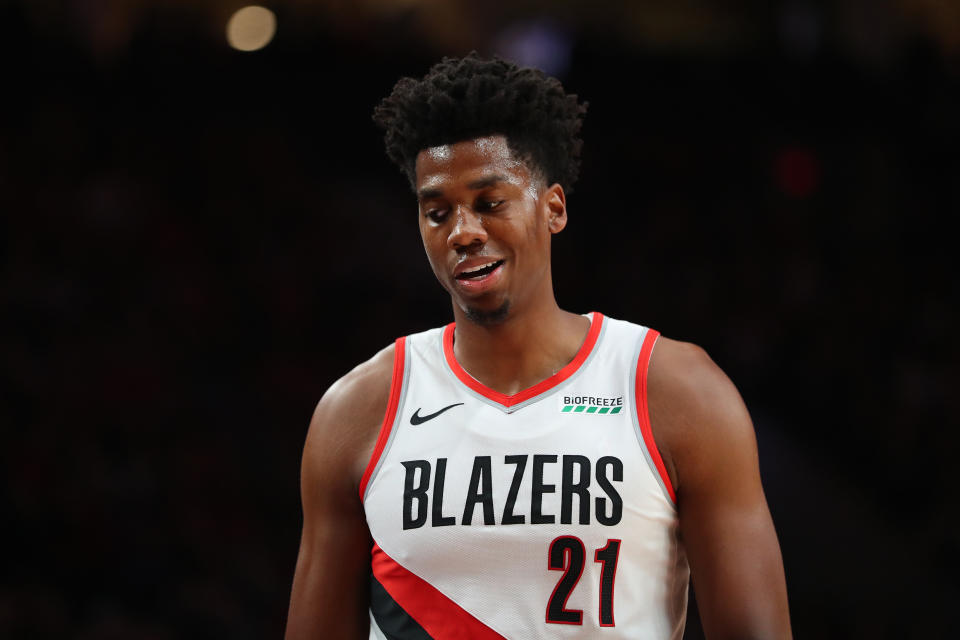Hassan Whiteside bears blame, but Portland's problems run deep
During halftime of a third straight Portland Trail Blazers defeat on Thursday, when Los Angeles Clippers center Ivica Zubac was outplaying Hassan Whiteside, “Inside the NBA” analysts Shaquille O’Neal and Charles Barkley lit into Portland’s biggest offseason acquisition for his lethargic approach to the game.
“He’s playing with no effort,” O’Neal said of Whiteside.
After a lengthy discussion of whether Whiteside’s history of maddening lack of performance has more to do with effort or know-how, Kenny Smith asked, “Do you think he knows what his strengths are.”
“Yeah,” countered Barkley, “going to the bank twice a month. That’s his strength. ... Stealing money.”
Asked about the exchange after the loss, Whiteside told reporters, “Man, I expect Shaq to diss. [Damian Lillard] killed him in a rap battle. We ain’t going to hearing anything positive from Shaq ever again.”
It says something about Whiteside that he thinks their remarks are rooted in a rap battle, especially after the Miami Heat’s Pat Riley and Erik Spoelstra levied similar criticisms for years without laying down bars about Dame Dolla, but it does not tell the whole story of why the Blazers are struggling out of the gate.
Portland practically revamped its entire roster around star guards Lillard and C.J. McCollum after making a run to the Western Conference finals grounded in continuity and chemistry, and through eight games the returns have been lackluster at best. The Blazers traded Mo Harkless and Meyers Leonard in the deal to land Whiteside, trying to stem the tide until center Jusuf Nurkic returns from a broken leg, and then let free agent Al-Farouq Aminu walk in favor of stopgaps Anthony Tolliver and Mario Hezonja.
They replaced three guys who have all played together since 2015 with a trio of players Lillard and McCollum have yet to fully trust. The shoulder injury to promising stretch big Zach Collins has not helped matters, and the swap of Evan Turner for Kent Bazemore might also have altered the chemistry.
The result has been an even heavier reliance on their backcourt. It is one thing to count on Lillard and McCollum to carry the offense and another to depend on them for everything. They are finishing almost 40 percent more possessions than last year in isolation or as the ball-handler in the pick-and-roll. That is not always the worst thing. Lillard has been ludicrously good, averaging 30 points on 48/39/88 splits as maybe the league’s best pick-and-roll player, but McCollum has been far less efficient working off picks. Whiteside has actually been fairly effective as a finisher, but he is more interested in his roll than a pick.

Life is more difficult for them in an offense that features nobody else capable of creating offense and only Rodney Hood as a safety valve on the 3-point line (48 percent on four attempts per game). As a result, the Blazers rank dead last in assists per 100 possessions and percentage of field goals assisted.
Turner was helpful from a playmaking perspective, as was Nurkic, whose willingness to share created five potential assists per game last season, according to Second Spectrum’s tracking data. Whiteside is practically non-existent in that regard, often refusing to pass when engulfed by defenders in the paint. (This is to say nothing of his lack of force on the interior and penchant for difficult 7-foot bunnies.)
Leonard and free-agency departure Seth Curry shot a combined 45 percent on five 3-point attempts per game last season. Harkless and Aminu were streaky at best, but they were somewhat respected from distance by both friend and foe. Collins was supposed to fill some of this void. Instead, Bazemore, Hezonja and Tolliver have shown little early on to deserve the same looks, shooting 22-of-70 from deep on a team that ranks last in spot-up shooting opportunities and second to last in spot-up effectiveness.
Opponents can help even more on Lillard and McCollum, thwarting them the same way the New Orleans Pelicans and Golden State Warriors succeeded in sweeping them from the playoffs the past two years. And teams packing the paint on them this season might also contribute to another major issue for the Blazers: They rank 27th in rebound percentage through eight games after leading the NBA last season.
Whiteside has replaced the rebounding void left by Nurkic (and Kanter), grabbing 25 percent of available boards this season, but Aminu, Turner and Harkless were all better on the glass than their replacements.
They were also better defenders. Lillard and McCollum have never been stalwarts on that end, even if they have improved dramatically, but they look worse when there is nobody to help defend on the wing. Portland actually depended on Hezonja opposite Kawhi Leonard for stretches in Thursday night’s loss.
Worse, yet, Whiteside has provided no resistance on the interior. Opponents are shooting 68.9 percent at the rim against him, per Second Spectrum, the highest percentage against anyone who has played at least five games this year. The player next on that list? Whiteside’s backup in Portland, Skal Labissiere. The Blazers rank bottom 10 in points in the paint allowed and 29th in second-chance points allowed.
“We’re not physical enough, we’re allowing teams to get comfortable,” Lillard told The Oregonian’s Joe Freeman after the loss to the Clippers. “In the NBA, if you let teams get comfortable and start to feel good about themselves, you’re going to be in a for a long night. I think that’s been the case this year more times than not. And the beginning of the game is where you set the tone. Being physical, taking things away, making guys work. How you set the tone is important.”
Hope is not lost. The chemistry on both ends can only get better, even if the new additions do not rise to the level of effectiveness as their predecessors. If the Blazers can motivate Whiteside for the next few months, reinforcements are coming. Nurkic is expected back at some point between the turn of the calendar and the All-Star break, and Collins may well return before the playoffs. Hood has played well enough that the Blazers will be able to field a formidable lineup if they can solve the four spot, especially if Anfernee Simons emerges as the third playmaking guard everyone expected him to be this summer.
To that end, Portland may be among the most active teams on the trade market. They have a wealth of expiring contracts (Whiteside and Bazemore make $46 million combined in the final year of their deals), along with recent first-round picks Simons and Nassir Little and all of their own future first-rounders. Oregon native Kevin Love has long been linked to the Blazers. He would be an ideal fit, and Oklahoma City’s Danilo Gallinari is not a bad second option if Love proves too difficult to pry away from Cleveland.
Eight games is probably too early to panic, and Blazers coach Terry Stotts has a track record of maximizing his roster’s effectiveness, but if this early hole gets any deeper, Portland could be R.I.P. city.
– – – – – – –
Ben Rohrbach is a staff writer for Yahoo Sports. Have a tip? Email him at rohrbach_ben@yahoo.com or follow him on Twitter! Follow @brohrbach
More from Yahoo Sports:


